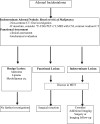Recommendations for the management of adrenal incidentalomas: what is pertinent for radiologists?
- PMID: 28181818
- PMCID: PMC5605062
- DOI: 10.1259/bjr.20160627
Recommendations for the management of adrenal incidentalomas: what is pertinent for radiologists?
Abstract
Adrenal incidentalomas are unsuspected, asymptomatic adrenal masses detected on imaging. Most are non-functioning benign adrenocortical adenomas but can represent other benign lesions or lesions requiring therapeutic intervention including adrenocortical carcinoma, pheochromocytoma, hormone-producing adenoma or metastasis. This review summarizes and highlights radiological recommendations within the recently issued guidelines for the management of adrenal incidentalomas from the European Society of Endocrinology Clinical Practice in collaboration with the European Network for Study of Adrenal Tumours. Four pre-defined clinical questions were addressed in the guidelines and two have specific relevance and implications for radiologists: (1) how to assess risk of malignancy on imaging and (2) what follow-up is indicated if an adrenal incidentaloma is not surgically removed? The guidelines also include recommendations for frequently encountered special circumstances, including bilateral incidentalomas, incidentalomas in patients with extra-adrenal malignancy and in the young and elderly patients. This review highlights radiological recommendations within the guidelines and evidence used for formulating the guidelines.
Figures


References
-
- Barzon L, Scaroni C, Sonino N, Fallo F, Paoletta A, Boscaro M. Risk factors and long-term follow-up of adrenal incidentalomas. J Clin Endocrinol Metab 1999; 84: 520–6. doi: https://doi.org/10.1210/jcem.84.2.5444 - DOI - PubMed
-
- Barzon L, Sonino N, Fallo F, Palu G, Boscaro M. Prevalence and natural history of adrenal incidentalomas. Eur J Endocrinol 2003; 149: 273–85. - PubMed
-
- Cawood TJ, Hunt PJ, O'Shea D, Cole D, Soule S. Recommended evaluation of adrenal incidentalomas is costly, has high false-positive rates and confers a risk of fatal cancer that is similar to the risk of the adrenal lesion becoming malignant; time for a rethink? Eur J Endocrinol 2009; 161: 513–27. - PubMed
-
- Favia G, Lumachi F, Basso S, D'Amico DF. Management of incidentally discovered adrenal masses and risk of malignancy. Surgery 2000; 128: 918–24. doi: https://doi.org/10.1067/msy.2000.109965 - DOI - PubMed
-
- Grumbach MM, Biller BM, Braunstein GD, Campbell KK, Carney JA, Godley PA, et al. . Management of the clinically inapparent adrenal mass (“incidentaloma”). Ann Intern Med 2003; 138: 424–9. - PubMed
Publication types
MeSH terms
Supplementary concepts
LinkOut - more resources
Full Text Sources
Other Literature Sources
Medical

